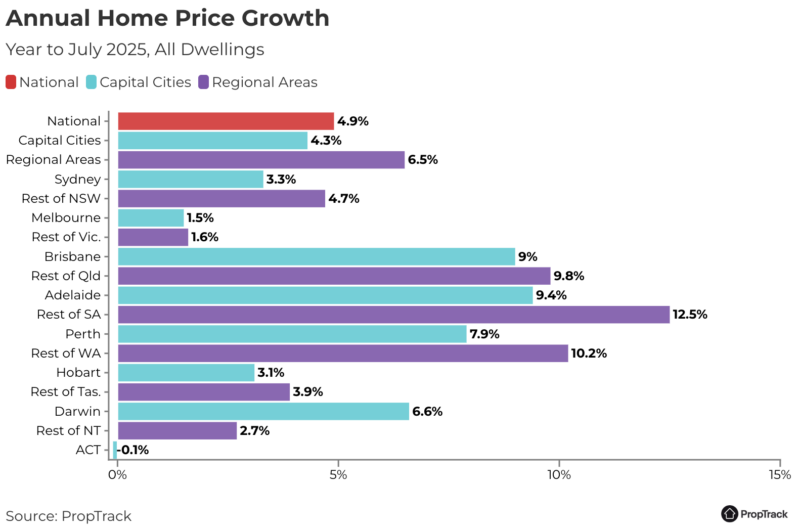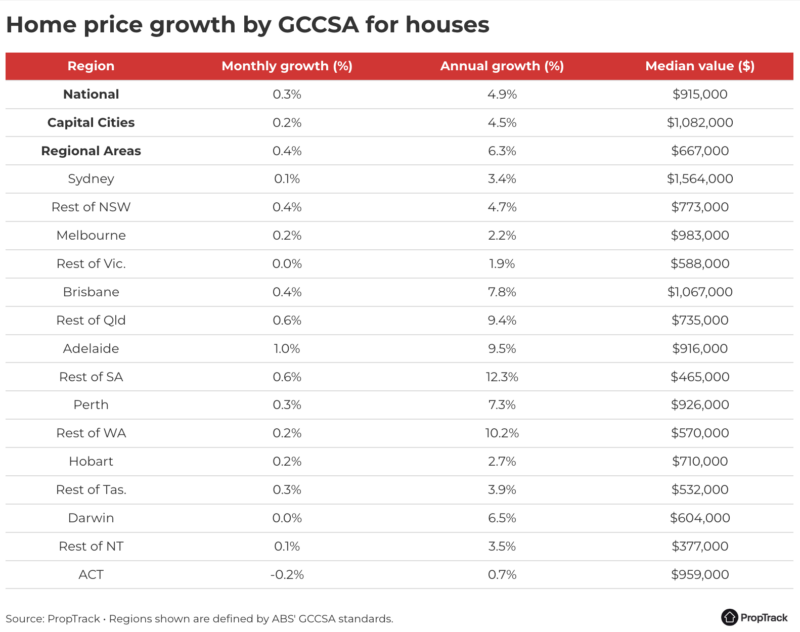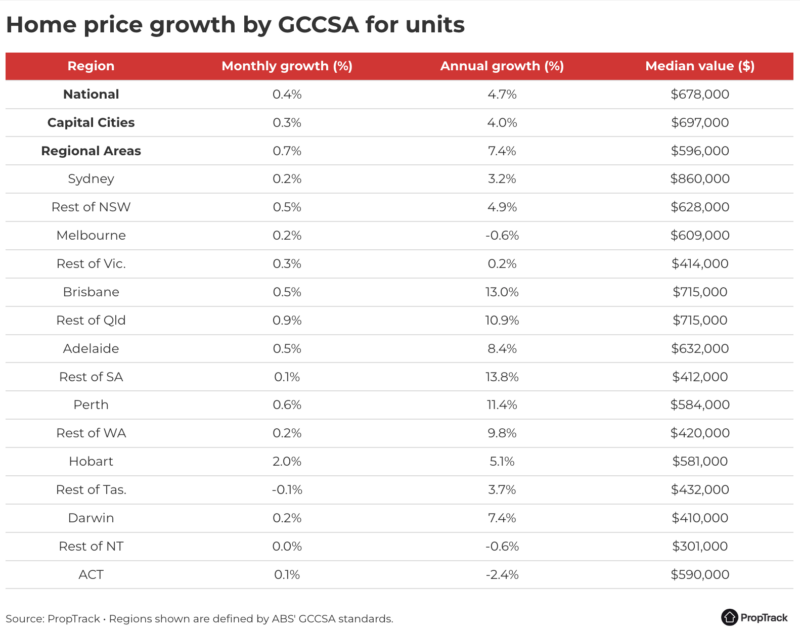
Key takeaways
National home prices hit a new record high of $827,000 in July, following a rise of 0.3% over the month and 4.9% over the year.
Regional areas have outperformed their capital city counterparts in most states, up 0.4% over the month and 6.5% over the year.
Capital city prices climbed 0.3% over July and are sitting 4.3% higher compared to a year ago.
Prices increased in every capital city and regional area with the exception of Canberra (-0.1%).
Adelaide remains the strongest performing capital, recording the highest growth over both the month (0.9%) and the year (9.4%). Hobart followed, with prices up 0.5% over the month, however year-on-year growth was more moderate (3.1%).
Brisbane (0.4%) and Perth (0.4%) also posted strong growth over the month, with annual growth sitting at 9% and 7.9%, respectively.
Price growth was more subdued in Sydney (0.1%), Melbourne (0.2%), and Darwin (0.1%) over the month, with each city sitting higher than a year ago.
Home prices reached a record high, rising 0.3% in July and 4.9% in the past year, according to Proptrack.
Australia’s median home price hit a new record high in July, but the pace of growth slowed over the month.
The median price of a house is now sitting at $915,000 nationally, with the median unit price $678,000.
Home prices in capital cities are even higher, with the median price of a house surpassing $1 million this quarter to reach $1,082,000 in July, while units were $697,000.
Key findings from the July 2025 report:
- National home prices hit a new record high of $827,000 in July, following a rise of 0.3% over the month and 4.9% over the year.
- Regional areas have outperformed their capital city counterparts in most states, up 0.4% over the month and 6.5% over the year.
- Capital city prices climbed 0.3% over July and are sitting 4.3% higher compared to a year ago.
- Prices increased in every capital city and regional area with the exception of Canberra (-0.1%).
- Adelaide remains the strongest performing capital, recording the highest growth over both the month (0.9%) and the year (9.4%). Hobart followed, with prices up 0.5% over the month, however year-on-year growth was more moderate (3.1%).
- Brisbane (0.4%) and Perth (0.4%) also posted strong growth over the month, with annual growth sitting at 9% and 7.9%, respectively.
- Price growth was more subdued in Sydney (0.1%), Melbourne (0.2%), and Darwin (0.1%) over the month, with each city sitting higher than a year ago.
Anne Flaherty, Proptrack economist explained:
Despite the lift in values, the rise of 0.3% was the smallest seen so far this year.
In part, this may have been due to the Reserve Bank’s surprise decision to keep interest rates on hold in July, despite the market widely expecting a cut.
Units slightly outperformed over July, recording 0.4% growth compared to 0.3% growth for houses. Year-on-year, however, houses are slightly ahead, up 4.9% versus 4.7% for units.
Despite the national trend, many capital cities have seen unit markets significantly outperform houses, the most notable being Brisbane (13% vs 7.8%) and Perth (11.4% vs 7.3%).
The markets are changing
The two-speed property market is levelling out as momentum in many of the fastest growing regions starts to fade according to Angus Moore, Senior Economist at Proptrack.
Price growth so far across 2025 has been a lot more consistent across the country than has been the case for some time.
Unlike last year, prices are growing consistently in Sydney and Melbourne, and the smaller capitals are recording slower growth this year after very strong growth over the past five years.
Regions that were outperforming last year and necessarily doing this that this year according to Moore who explained:
Rather, most of the country is seeing consistent, but unspectacular growth – particularly relative to the pace we’ve seen in some areas in recent years.
Whether this convergence continues remains to be seen.
Home prices are likely to continue to grow this year, on the back of further interest rate cuts and easing mortgage costs. However, the pace of growth is likely to remain modest, as it has been in much of the county this year, given affordability remains stretched.
Outlook
Searches to buy homes on realestate.com.au are also sitting higher compared to a year ago – a good indicator of upcoming demand.
There is also growing evidence of a ‘fear of missing out’ among buyers.
According to the Westpac-Melbourne Institute’s July Consumer Sentiment Index, three quarters of consumers surveyed expect home prices to rise over the next 12 months.
Price growth in July was the slowest this year, but demand is strong and auction clearance rates are high.
Earlier this week, Consumer Price Index data for the June quarter was released, showing that year-on-year inflation has continued to moderate.
This increases the chance of an interest rate cut in August, with more forecasters expecting at least one more rate cut before the end of the year.
Lower interest rates will help to improve borrowing capacities and add to price growth momentum.
Tempering growth, however, affordability remains a key barrier for many buyers.

















